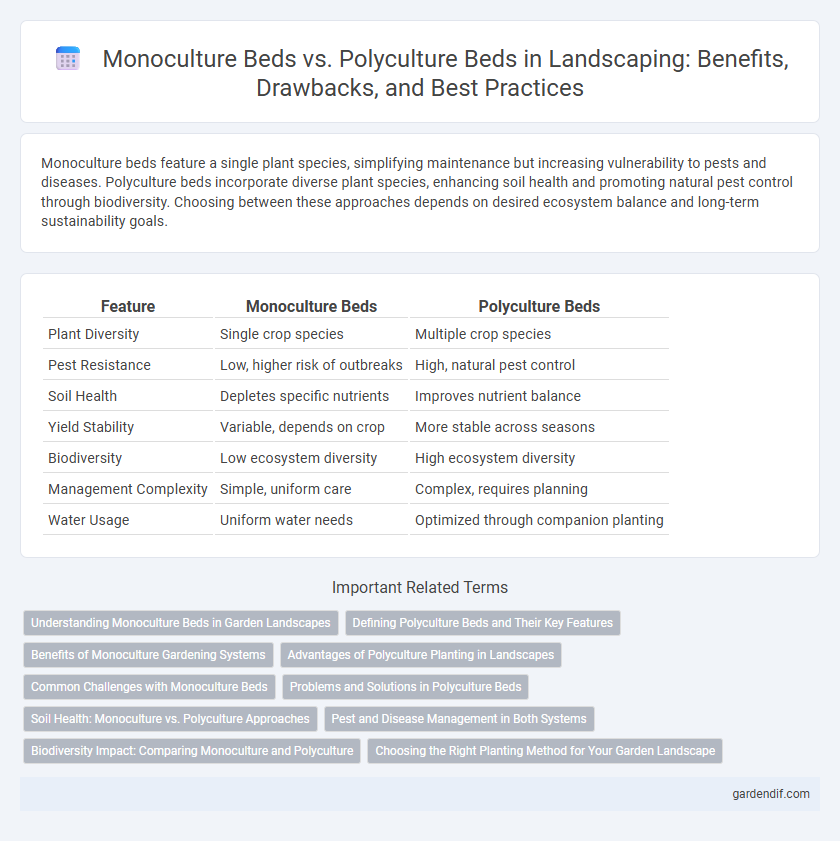
Monoculture Beds vs Polyculture Beds Illustration
Monoculture beds feature a single plant species, simplifying maintenance but increasing vulnerability to pests and diseases. Polyculture beds incorporate diverse plant species, enhancing soil health and promoting natural pest control through biodiversity. Choosing between these approaches depends on desired ecosystem balance and long-term sustainability goals.
Table of Comparison
| Feature | Monoculture Beds | Polyculture Beds |
|---|---|---|
| Plant Diversity | Single crop species | Multiple crop species |
| Pest Resistance | Low, higher risk of outbreaks | High, natural pest control |
| Soil Health | Depletes specific nutrients | Improves nutrient balance |
| Yield Stability | Variable, depends on crop | More stable across seasons |
| Biodiversity | Low ecosystem diversity | High ecosystem diversity |
| Management Complexity | Simple, uniform care | Complex, requires planning |
| Water Usage | Uniform water needs | Optimized through companion planting |
Understanding Monoculture Beds in Garden Landscapes
Monoculture beds in garden landscapes feature a single plant species cultivated in a defined area, simplifying maintenance and pest management. These beds can enhance visual uniformity and make nutrient management more predictable but may increase vulnerability to pests and diseases due to reduced biodiversity. Gardeners should carefully select resilient plant species and implement integrated pest management to sustain health and productivity in monoculture beds.
Defining Polyculture Beds and Their Key Features
Polyculture beds are garden spaces designed to cultivate multiple plant species simultaneously, promoting biodiversity and natural pest control. Key features include varied plant heights, root structures, and growth habits that enhance soil health, optimize nutrient cycling, and increase resilience against diseases. This contrasts with monoculture beds, which grow a single crop and often require more intensive management and chemical inputs.
Benefits of Monoculture Gardening Systems
Monoculture beds enhance crop uniformity and simplify pest and disease management by focusing on a single plant species, resulting in streamlined maintenance and harvesting processes. This gardening system enables precise nutrient management tailored to specific crop requirements, improving overall plant health and yield. Monoculture beds also allow efficient use of space and resources, making them ideal for large-scale production and mechanization.
Advantages of Polyculture Planting in Landscapes
Polyculture beds enhance biodiversity by supporting a variety of plants that improve soil health and reduce pests naturally. They promote sustainable landscapes through efficient resource use, such as water and nutrients, minimizing the need for chemical inputs. Diverse planting in polyculture beds creates resilient ecosystems that can better withstand environmental stresses like drought and disease.
Common Challenges with Monoculture Beds
Monoculture beds often face significant challenges including increased susceptibility to pests and diseases due to genetic uniformity, leading to higher reliance on chemical pesticides. Soil degradation and nutrient depletion are common as single crops repeatedly extract specific nutrients without variation, reducing long-term soil health. Limited biodiversity in monoculture systems restricts ecosystem services such as natural pest control and pollination, making crop production less resilient to environmental stressors.
Problems and Solutions in Polyculture Beds
Polyculture beds face challenges such as increased competition for resources, pest management complexity, and potential allelopathy between plant species. Solutions include selecting compatible plant combinations, using integrated pest management strategies, and implementing proper spacing and crop rotation to maintain soil health and biodiversity. Enhancing soil fertility with organic amendments and monitoring plant health regularly can further optimize polyculture bed performance.
Soil Health: Monoculture vs. Polyculture Approaches
Monoculture beds often lead to soil nutrient depletion and increased vulnerability to pests due to the repetitive cultivation of a single crop species. Polyculture beds enhance soil health by promoting biodiversity, improving nutrient cycling, and fostering beneficial microbial communities. Diverse root systems in polyculture beds also aid in maintaining soil structure and reducing erosion.
Pest and Disease Management in Both Systems
Monoculture beds often face higher risks of pest outbreaks and disease due to the uniformity of plant species, which provides a consistent food source for specific pests and pathogens. Polyculture beds enhance pest and disease management by promoting biodiversity, which supports natural predators and reduces vulnerability through varied plant resistance. Integrating multiple species disrupts pest life cycles and decreases the likelihood of widespread infestations, leading to healthier and more resilient landscapes.
Biodiversity Impact: Comparing Monoculture and Polyculture
Monoculture beds significantly reduce biodiversity by supporting a single plant species, which increases vulnerability to pests and diseases and depletes soil nutrients. Polyculture beds enhance biodiversity by cultivating multiple complementary plant species, promoting ecosystem resilience and improving soil health. This diverse planting strategy supports a wider range of beneficial insects, microorganisms, and wildlife, ultimately fostering sustainable landscape ecosystems.
Choosing the Right Planting Method for Your Garden Landscape
Monoculture beds simplify maintenance by focusing on a single plant species, which can enhance uniform growth but increase vulnerability to pests and diseases. Polyculture beds promote biodiversity by combining multiple plant species, improving soil health and resilience while creating a dynamic visual landscape. Selecting between monoculture and polyculture methods depends on garden goals, space availability, and desired ecosystem benefits for sustainable landscape design.
Monoculture Beds vs Polyculture Beds Infographic

 gardendif.com
gardendif.com